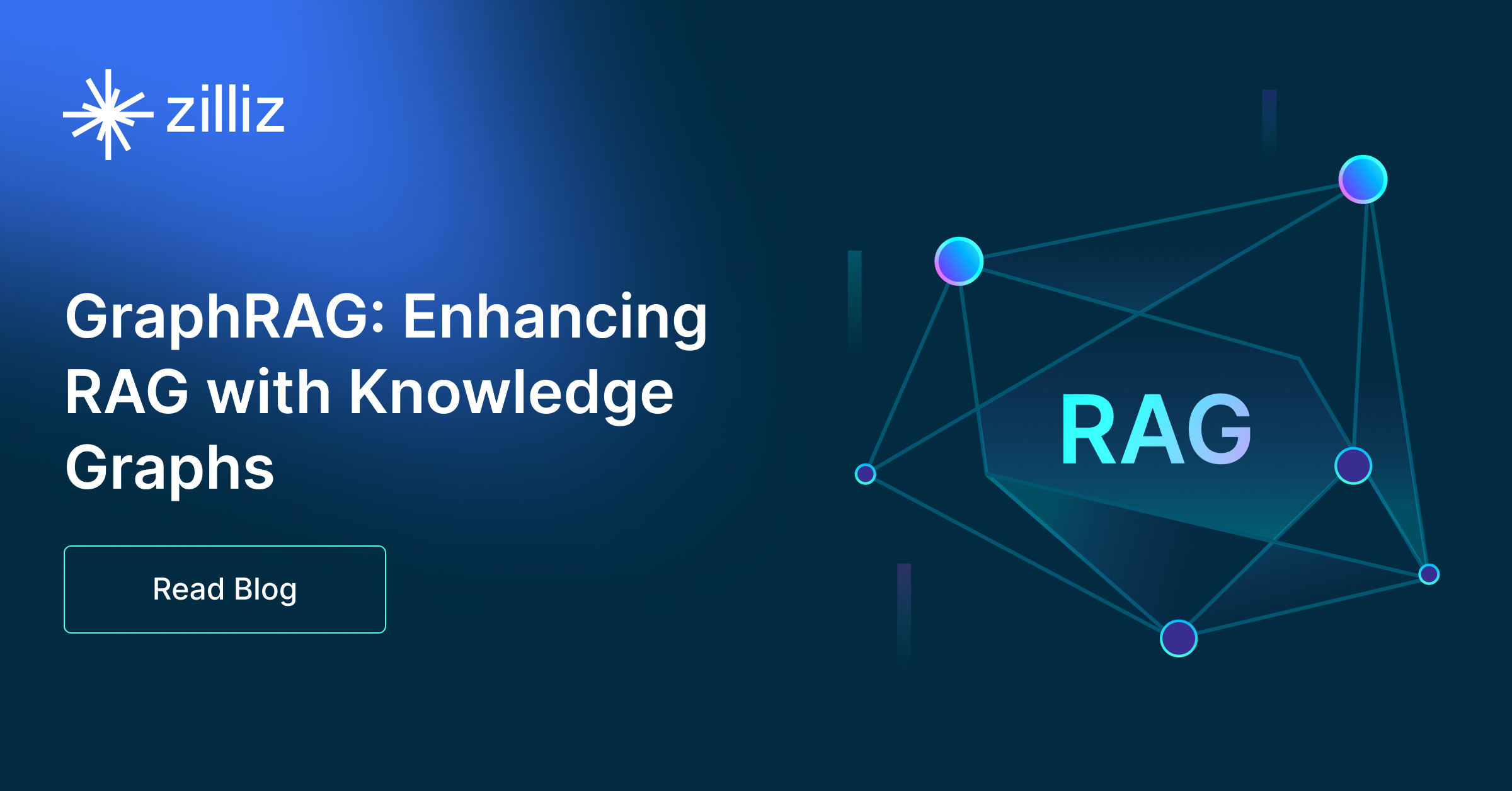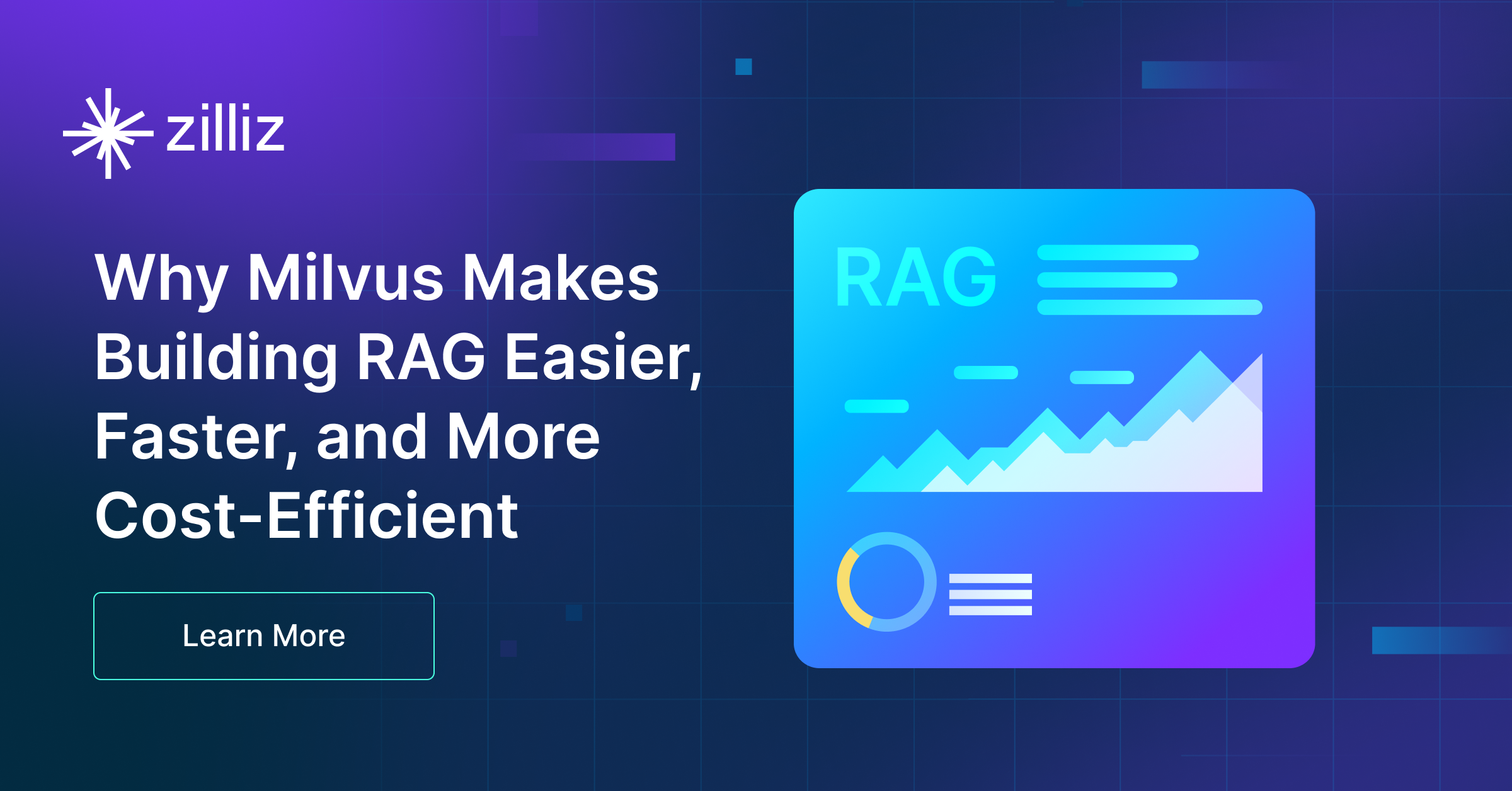Build RAG Chatbot with Haystack, Haystack In-memory store, Google Vertex AI Gemini 2.0 Flash-Lite, and BAAI llm-embedder
Introduction to RAG
Retrieval-Augmented Generation (RAG) is a game-changer for GenAI applications, especially in conversational AI. It combines the power of pre-trained large language models (LLMs) like OpenAI’s GPT with external knowledge sources stored in vector databases such as Milvus and Zilliz Cloud, allowing for more accurate, contextually relevant, and up-to-date response generation. A RAG pipeline usually consists of four basic components: a vector database, an embedding model, an LLM, and a framework.
Key Components We'll Use for This RAG Chatbot
This tutorial shows you how to build a simple RAG chatbot in Python using the following components:
- Haystack: An open-source Python framework designed for building production-ready NLP applications, particularly question answering and semantic search systems. Haystack excels at retrieving information from large document collections through its modular architecture that combines retrieval and reader components. Ideal for developers creating search applications, chatbots, and knowledge management systems that require efficient document processing and accurate information extraction from unstructured text.
- Haystack in-memory store: a very simple, in-memory document store with no extra services or dependencies. It is great for experimenting with Haystack, and we do not recommend using it for production. If you want a much more scalable solution for your apps or even enterprise projects, we recommend using Zilliz Cloud, which is a fully managed vector database service built on the open-source Milvusand offers a free tier supporting up to 1 million vectors.)
- Google Vertex AI Gemini 2.0 Flash-Lite: A lightweight, high-speed AI model optimized for rapid inference and low-latency applications. Designed for scalability and cost-efficiency, it excels in real-time processing, large-scale deployments, and scenarios requiring quick decision-making, such as chatbots, dynamic content generation, and real-time analytics. Ideal for enterprises prioritizing performance and resource optimization.
- BAAI llm-embedder: A unified embedding model designed to enhance retrieval-augmented LLMs by generating high-quality text representations. It excels in cross-domain knowledge integration, robustness, and semantic accuracy, making it ideal for retrieval systems, question answering, and textual analysis tasks requiring precise contextual understanding and scalability.
By the end of this tutorial, you’ll have a functional chatbot capable of answering questions based on a custom knowledge base.
Note: Since we may use proprietary models in our tutorials, make sure you have the required API key beforehand.
Step 1: Install and Set Up Haystack
import os
import requests
from haystack import Pipeline
from haystack.components.converters import MarkdownToDocument
from haystack.components.preprocessors import DocumentSplitter
from haystack.components.writers import DocumentWriter
Step 2: Install and Set Up Google Vertex AI Gemini 2.0 Flash-Lite
Using theVertexAIGeminiGenerator with Haystack requires authentication using Google Cloud Application Default Credentials (ADCs). This means your application must be set up with credentials that allow it to access Google Cloud services. If you're not sure how to configure ADCs, check the official Google documentation for setup instructions.
It's important to use a Google Cloud account that has the right permissions to access a project with Google Vertex AI endpoints. Without proper access, the generator won’t work as expected.
To find your project ID, you can either look it up in the Google Cloud Console under the resource manager or run the following command in your terminal.
Now let's install and set up this model.
pip install google-vertex-haystack
from haystack_integrations.components.generators.google_vertex import VertexAIGeminiGenerator
generator = VertexAIGeminiGenerator(model="gemini-1.5-flash")
Step 3: Install and Set Up BAAI llm-embedder
from haystack import Document
from haystack.components.embedders import SentenceTransformersDocumentEmbedder
from haystack.components.embedders import SentenceTransformersTextEmbedder
doc_embedder = SentenceTransformersDocumentEmbedder(model="BAAI/llm-embedder")
doc_embedder.warm_up()
text_embedder = SentenceTransformersTextEmbedder(model="BAAI/llm-embedder")
text_embedder.warm_up()
Step 4: Install and Set Up Haystack In-memory store
from haystack.document_stores.in_memory import InMemoryDocumentStore
from haystack.components.retrievers import InMemoryEmbeddingRetriever
document_store = InMemoryDocumentStore()
retriever=InMemoryEmbeddingRetriever(document_store=document_store))
Step 5: Build a RAG Chatbot
Now that you’ve set up all components, let’s start to build a simple chatbot. We’ll use the Milvus introduction doc as a private knowledge base. You can replace it your own dataset to customize your RAG chatbot.
url = 'https://raw.githubusercontent.com/milvus-io/milvus-docs/refs/heads/v2.5.x/site/en/about/overview.md'
example_file = 'example_file.md'
response = requests.get(url)
with open(example_file, 'wb') as f:
f.write(response.content)
file_paths = [example_file] # You can replace it with your own file paths.
indexing_pipeline = Pipeline()
indexing_pipeline.add_component("converter", MarkdownToDocument())
indexing_pipeline.add_component("splitter", DocumentSplitter(split_by="sentence", split_length=2))
indexing_pipeline.add_component("embedder", document_embedder)
indexing_pipeline.add_component("writer", DocumentWriter(document_store))
indexing_pipeline.connect("converter", "splitter")
indexing_pipeline.connect("splitter", "embedder")
indexing_pipeline.connect("embedder", "writer")
indexing_pipeline.run({"converter": {"sources": file_paths}})
# print("Number of documents:", document_store.count_documents())
question = "What is Milvus?" # You can replace it with your own question.
retrieval_pipeline = Pipeline()
retrieval_pipeline.add_component("embedder", text_embedder)
retrieval_pipeline.add_component("retriever", retriever)
retrieval_pipeline.connect("embedder", "retriever")
retrieval_results = retrieval_pipeline.run({"embedder": {"text": question}})
# for doc in retrieval_results["retriever"]["documents"]:
# print(doc.content)
# print("-" * 10)
from haystack.utils import Secret
from haystack.components.builders import PromptBuilder
retriever=InMemoryEmbeddingRetriever(document_store=document_store)
text_embedder = SentenceTransformersTextEmbedder(model="BAAI/llm-embedder")
text_embedder.warm_up()
prompt_template = """Answer the following query based on the provided context. If the context does
not include an answer, reply with 'I don't know'.\n
Query: {{query}}
Documents:
{% for doc in documents %}
{{ doc.content }}
{% endfor %}
Answer:
"""
rag_pipeline = Pipeline()
rag_pipeline.add_component("text_embedder", text_embedder)
rag_pipeline.add_component("retriever", retriever)
rag_pipeline.add_component("prompt_builder", PromptBuilder(template=prompt_template))
rag_pipeline.add_component("generator", generator)
rag_pipeline.connect("text_embedder.embedding", "retriever.query_embedding")
rag_pipeline.connect("retriever.documents", "prompt_builder.documents")
rag_pipeline.connect("prompt_builder", "generator")
results = rag_pipeline.run({"text_embedder": {"text": question}, "prompt_builder": {"query": question},})
print('RAG answer:\n', results["generator"]["replies"][0])
Optimization Tips
As you build your RAG system, optimization is key to ensuring peak performance and efficiency. While setting up the components is an essential first step, fine-tuning each one will help you create a solution that works even better and scales seamlessly. In this section, we’ll share some practical tips for optimizing all these components, giving you the edge to build smarter, faster, and more responsive RAG applications.
Haystack optimization tips
To optimize Haystack in a RAG setup, ensure you use an efficient retriever like FAISS or Milvus for scalable and fast similarity searches. Fine-tune your document store settings, such as indexing strategies and storage backends, to balance speed and accuracy. Use batch processing for embedding generation to reduce latency and optimize API calls. Leverage Haystack's pipeline caching to avoid redundant computations, especially for frequently queried documents. Tune your reader model by selecting a lightweight yet accurate transformer-based model like DistilBERT to speed up response times. Implement query rewriting or filtering techniques to enhance retrieval quality, ensuring the most relevant documents are retrieved for generation. Finally, monitor system performance with Haystack’s built-in evaluation tools to iteratively refine your setup based on real-world query performance.
Haystack in-memory store optimization tips
Haystack in-memory store is just a very simple, in-memory document store with no extra services or dependencies. We recommend that you just experiment it with RAG pipeline within your Haystack framework, and we do not recommend using it for production. If you want a much more scalable solution for your apps or even enterprise projects, we recommend using Zilliz Cloud, which is a fully managed vector database service built on the open-source Milvusand offers a free tier supporting up to 1 million vectors
Google Vertex AI Gemini 2.0 Flash-Lite optimization tips
Optimize Gemini 2.0 Flash-Lite in RAG by preprocessing inputs to remove noise and standardize formats, ensuring cleaner context for retrieval. Adjust temperature and top-k values to balance creativity and relevance in outputs. Use smaller document chunks (e.g., 512 tokens) during retrieval to reduce latency and improve alignment with the model’s token limits. Cache frequent queries and responses to lower API costs and latency. Enable streaming for real-time applications and batch requests where feasible. Regularly validate outputs for accuracy and trim redundant content. Fine-tune with domain-specific data if available, and monitor usage metrics to adjust scaling dynamically.
BAAI llm-embedder optimization tips
Optimize BAAI llm-embedder in RAG by normalizing input text (lowercasing, removing special characters) to reduce noise, batching inference for efficiency, and fine-tuning on domain-specific data if labeled examples are available. Use dynamic truncation or padding to handle variable-length inputs, and cache frequent queries to minimize recomputation. Experiment with pooling strategies (e.g., CLS token vs. mean-pooling) for optimal semantic capture. Regularly evaluate retrieval accuracy via recall@k metrics and consider hybrid retrieval (dense + sparse) to balance precision and coverage. Monitor latency and memory usage to scale effectively.
By implementing these tips across your components, you'll be able to enhance the performance and functionality of your RAG system, ensuring it’s optimized for both speed and accuracy. Keep testing, iterating, and refining your setup to stay ahead in the ever-evolving world of AI development.
RAG Cost Calculator: A Free Tool to Calculate Your Cost in Seconds
Estimating the cost of a Retrieval-Augmented Generation (RAG) pipeline involves analyzing expenses across vector storage, compute resources, and API usage. Key cost drivers include vector database queries, embedding generation, and LLM inference.
RAG Cost Calculator is a free tool that quickly estimates the cost of building a RAG pipeline, including chunking, embedding, vector storage/search, and LLM generation. It also helps you identify cost-saving opportunities and achieve up to 10x cost reduction on vector databases with the serverless option.
 Calculate your RAG cost
Calculate your RAG cost
What Have You Learned?
By diving into this tutorial, you’ve taken a huge leap into the world of RAG systems—and look how much you’ve accomplished! You learned how to weave together four powerful tools to create a seamless, intelligent pipeline. First, Haystack served as your trusty framework, providing the scaffolding to connect everything effortlessly. Then, the Haystack In-Memory Store stepped in as your lightning-fast vector database, keeping your data organized and ready for instant retrieval. You saw how the BAAI llm-embedder transformed raw text into rich, meaningful embeddings, giving your system the ability to understand context rather than just scan keywords. And let’s not forget Google Vertex AI Gemini 2.0 Flash-Lite—your LLM powerhouse—that turned those retrieved snippets into coherent, human-like responses. How cool is that? Plus, you picked up pro tips like optimizing chunk sizes and balancing speed with accuracy, ensuring your RAG system isn’t just functional but efficient. And that free RAG cost calculator? Total game-changer for keeping your projects budget-friendly without sacrificing performance.
Now, armed with this knowledge, you’re not just following steps—you’re ready to innovate! Imagine the apps you can build: chatbots that actually get your users, research tools that dig up insights in seconds, or creative assistants that spark new ideas. This tutorial was your launchpad, but the real adventure starts now. Tweak those parameters, experiment with different models, and let your curiosity guide you. The future of AI-driven solutions is yours to shape. So go ahead—fire up your IDE, play with the code, and watch your ideas come to life. You’ve got the tools, the know-how, and the creativity. Let’s build something amazing! 🚀
Further Resources
🌟 In addition to this RAG tutorial, unleash your full potential with these incredible resources to level up your RAG skills.
- How to Build a Multimodal RAG | Documentation
- How to Enhance the Performance of Your RAG Pipeline
- Graph RAG with Milvus | Documentation
- How to Evaluate RAG Applications - Zilliz Learn
- Generative AI Resource Hub | Zilliz
We'd Love to Hear What You Think!
We’d love to hear your thoughts! 🌟 Leave your questions or comments below or join our vibrant Milvus Discord community to share your experiences, ask questions, or connect with thousands of AI enthusiasts. Your journey matters to us!
If you like this tutorial, show your support by giving our Milvus GitHub repo a star ⭐—it means the world to us and inspires us to keep creating! 💖
- Introduction to RAG
- Key Components We'll Use for This RAG Chatbot
- Step 1: Install and Set Up Haystack
- Step 2: Install and Set Up Google Vertex AI Gemini 2.0 Flash-Lite
- Step 3: Install and Set Up BAAI llm-embedder
- Step 4: Install and Set Up Haystack In-memory store
- Step 5: Build a RAG Chatbot
- Optimization Tips
- RAG Cost Calculator: A Free Tool to Calculate Your Cost in Seconds
- What Have You Learned?
- Further Resources
- We'd Love to Hear What You Think!
Content
Vector Database at Scale
Zilliz Cloud is a fully-managed vector database built for scale, perfect for your RAG apps.
Try Zilliz Cloud for Free


